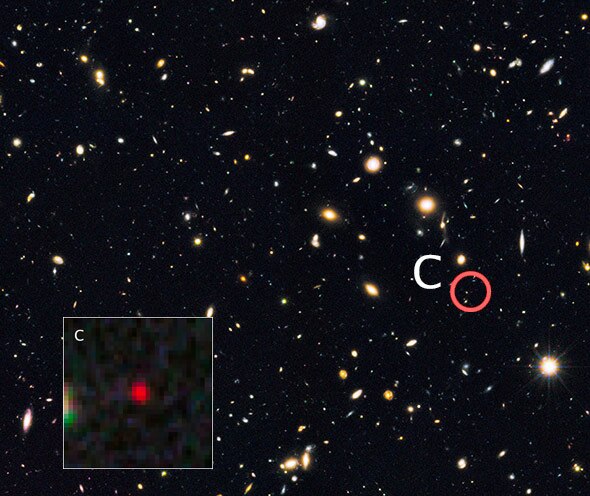Create a free profile to get unlimited access to exclusive videos, sweepstakes, and more!
Hubble Sees Infant Galaxies at the Edge of the Universe

Here are two things I love when it comes to astronomy: A truly cool Hubble image and a mystery. When you combine them, well, youâre on to something very cool indeed. And thatâs just what I have here for you.
First, the image: A staggeringly deep Hubble photograph showing thousands of galaxies like grains of sand on the beach:
I had to shrink this image a lot to get it to fit here. I strongly urge you get a higher-res version (especially the 3000 x 2400 pixel version). Because see all those dots? Those arenât stars. Those are galaxies. Thousands of them. Hubble stared at the same spot in the constellation of Ursa Major for hours, and it came up with this phenomenal image.
And what it also found, actually, was a mystery. In the image are four circled blobs, each very red and highlighted on the right; again, you might want to grab the big image to see this better. Here is one of them, called GNDJ-625464314 (Iâll call it GNDJ-625 for short) in detail:
Again, I remind you, nearly everything you see here is a galaxy, a vast collection of billions of stars. GNDJ-625 is circled, and I inset a zoomed-in shot of it in the lower left. Itâs a galaxy, as are the three others in the big image. You can tell right away theyâre hugely distant; the red color is due to their redshift, caused by their photons losing energy as they fight their way to us against the expansion of the Universe itself (I have a more detailed explanation of this in another article about distant galaxies).
And it turns out all four really are ridiculously far from Earth; GNDJ-625 is something like 13.2 billion light years away. In other words, weâre seeing it when the Universe itself was only about 600 million years old.Â
Our galaxy is well over 10 billion years old, for comparison. The galaxy in that picture is a wee baby.
But itâs a loud one. The Spitzer Space Telescope was used to determine how much energy is being emitted by these galaxies, and it turns out theyâre bright. Very, very bright, so bright they must be churning out new stars at a prodigious rate, maybe 50 times faster than our own Milky Way galaxy makes stars now. Thatâs incredibly prolific. GNDJ-625 itself is only about 1/20th the size of the Milky Way, so those stars, over a billion of them, are crammed pretty tightly together. All those young, hot stars are blasting out radiation, which is why we can see this galaxy at all at such a soul-crushing distance.
This in turn means the galaxies must be growing rapidly, possibly by gravitationally accreting gas, or by merging with other small galaxies. But given their young age, they must have done so at a fantastic rate to get as big and bright as we see them.
And itâs not at all clear how that could happen. Itâs also odd that four would be found so close together in the sky; it seems unlikely this would happen. Perhaps itâs a statistical fluke, or perhaps thereâs more going on here than we understand at first glance.
I will always bet on the latter.Â
But thatâs the beauty of probing as far as we can see; we get to test the literal limits of our knowledge, to push the mathematics and physics to see if we can figure out whatâs going on. The really interesting stuff tends to loiter at the outer edges of what we can do, and itâs those things that provide so much leverage when we test our hypothesis with them. We have a decent understanding of how galaxies grow to huge size (like our Milky Way) today, but when did they start this journey? How fast did they grow in the past, what material was available to them, how densely packed were the galaxies and the stars within? Was it something inside them to led to this growth, or something in their environment around them? Or both?
These objects will help us figure all that out. The observations here are part of a survey called GOODS, for Great Observatories Origins Deep Survey, specifically designed to look for the faintest galaxies at the most forbidding distances, to find what it could find.
I expect much, much more knowledge will be unearthed in this treasure chest of galaxies. Itâs funny to think that in a survey that goes so terribly deep, weâve only just scratched its surface.


























